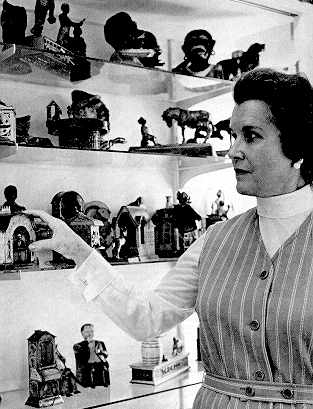PHOENIX, January 1972, Volume 8, Number 1
FASCINATING SLICE OF
EARLY AMERICANA
By Katharine Robertson
 A SIMPLE and rather
innocent hobby ended and an ardent collector was born when the excitement of research and
discovery took over," explained Mrs. G. Robert Herberger, of Scottsdale.
A SIMPLE and rather
innocent hobby ended and an ardent collector was born when the excitement of research and
discovery took over," explained Mrs. G. Robert Herberger, of Scottsdale.
Old Penny Banks of Early Americana in tin, lead and cast-iron first caught her eye in
1947, in an antique shop in Winnetka, Illinois. She became fascinated by the mechanical
ingenuity, great sculpturing (being a sculptress herself) and the social and economic
aspect of the toys. She made her first purchase ostensibly for her son, Gary. But, when
she began to canvass antique shops and dealers throughout the country she knew she was no
longer searching for a child's toy, but was on the way to becoming a determined collector.
She now has an impressive collection of one hundred and two mechanical banks and well over
three hundred 'stills,' which she displays in glass cases in her home.
The first, "Darktown Battery," has remained her favorite to this day. The most
treasured is "The Springing Cat." which is very rare and unusual - probably only
five or six known to be in existence. Made of lead, the cat sits on the Great Wall of
China and springs at a mouse when the penny is inserted.
Penny Banks made their first appearance in America around 1793, along with the first large
copper penny. Their popularity is credited by most authorities to Benjamin Franklin's
famous maxims concerning thrift, which were widely circulated in Poor Richard's
Almanac. The "savings bank" became a national habit and contributed in no
small way to the financial independence of this nation. The ingenious mechanical banks, or
action toys, lured children into the habit of saving, but appealed to adults as well, who
bought them in large quantities.
Since there are only around three hundred mechanical Penny Banks in existence, they are
difficult to find. Seven or eight years ago, Mrs. Herberger began adding stills to her
collection. Her first love remains the mechanical ones through which, as toys, our
forefathers taught their children the fun and challenge of thrift.
The banks are classified as common, good and rare. There is no definite literature on the
origin of the children's savings banks, but many iron foundries competed to produce the
most attractive and alluring toy banks. As shown by patents, they reached a peak of
popularity about 1885 and reflect the political and social events of the times. It has
been said that a comprehensive early American history could be written from them.
The mechanics of some of the toy banks are quite complicated. Mrs. Herberger's
"Reclining Chinaman" waves both hands. It was produced during a period of
resentment against this ethnic group. Following the discovery of gold in California in
1848, the Chinese were welcomed on the Pacific Coast because of the shortage of cooks,
gardeners, laundrymen and servants - jobs Americans didn't particularly relish. Later,
however, six companies under contract imported shiploads of indentured coolies and
assigned them to mining and shipping concerns. The situation resulted in reduction of
wages for all workers and precipitated the racial prejudice. The residents began referring
to them as the "Chinese menace." The bank features a Chinaman indolently
sprawled with a smirking, cunning smile on his face, holding a card containing all aces -
reference to their being lazy, corrupt and inveterate gamblers.
"Paddy and His Pig" reflects either prejudice against the Irish, which was
rampant following the tremendous influx of the immigrants in the 1830's to 1840's, or
sentiments of the intemperate, shanty-dwellers who practically lived with their pigs. The
Irishman smiles warmly at his pig and a flask protrudes from his pocket.
There are many thought-provoking Negro banks, "Cabin Bank" is a Darky in a
cabin. Then there's "I Always Did 'Spise a Mule," "Uncle Tom,"
"Jolly Nigger" and "Darktown Battery," with three Negroes playing
baseball.
Political events are reflected in many, like the "Tammany Bank." Put money into
the hand of a fat politician and he drops it into his pocket and nods his head.
Among Mrs. Herberger's other prizes is the "Uncle Sam" bank. A penny is placed
in his outstretched hand, the hand drops and the coin slips into a carpet bag at Uncle
Sam's side.
Mrs. Herberger is the only private collector in the state of Arizona belonging to the
Mechanical Bank Collectors of America, which was organized on September 27, 1958, at
Wakefield, in the town of South Kingston, Rhode Island. The organization was sponsored by
eight collectors who lived in the Rhode Island area, together with the well-known
collector and dealer, Frank L. Ball of Cambridge, Massachusetts, and Andrew Emerine of
Fostoria, Ohio, as honorary members. The membership in this exclusive group today is only
two hundred and five. Their recent national convention in Washington, D.C. was attended by
Mrs. Herberger.
After watching some of the animated banks work, it is easy to see what a thrill the
children of yesteryear had in saving pennies and what excitement today's collector has in
the discovery of them.
